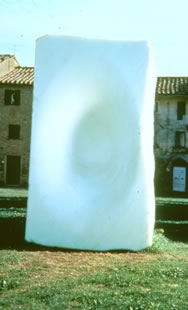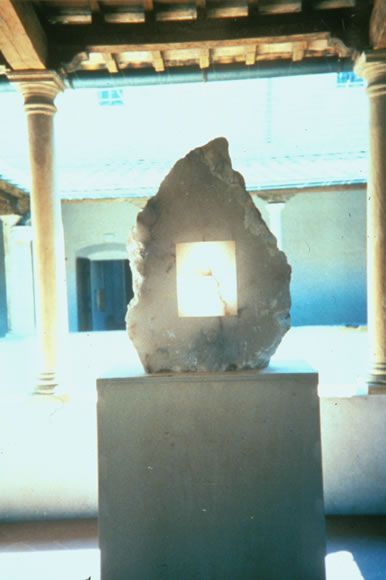 |
An art that creates a world
Let us start with two statements made by Anish Kapoor. They are taken
from the interview with Douglas Maxwell for Art Monthly in May,1990 which
was published in the catalogue for the artist's exhibition held in Milan
in 1995, whose organization was attended by Germano Celant by appointment
of the Fondazione Prada. The said statements seem to be very helpful in
attempting a first definition of this artist who is considered to be one
of the most interesting sculptors of the last fifteen years. "When
I was in India I used to paint. It was abstract painting and things like
that, in the early Pollock's style which is still fascinating to me. Rothko
and his time" and also "I am a painter who is a sculptor".
This paradox already poses questions regarding not only Kapoor's work
and artistic conception, but concerning the definition of art as a whole
for they are the same questions that people have in mind when they wonder
what this contemporary art really is, seeing as the painters describe
themselves as sculptors, the sculptors as painters, artists say they are
not artists any more and art is thought of as an anti-art.
A generally valid way of answering could be that of mentioning the eternal
dilemma between appearing and being. Therefore we must immedately point
out that Kapoor's statements make him rightfully part of that generation
of artists who, like Duchamp, develop alchemic issues and act according
to even paradoxical ideas or who, like Fontana, realize works that go
beyond appearances looking for the real being; they have another predecessor
in Judd, who said that "the new work seems obviously closer to sculpture
than it is to painting, but in reality it is closer to painting".
|
 |
| |
 |
In fact, Kapoor's statements reveal the nature of
a man who uses tridimensionality - which is part of sculpture and architecture,
and thus of the concrete reality - to explore the principles of surfaces
and of the illusory vision which are typical features of painting. Already
in his early works he used to cover up tridimensional forms like half-spheres,
cones, pyramids, parallelepipeds and the like with white, red, yellow
and blue powders. The choice of using the basic colors reminds us of painting,
just like the powders that question the tridimensionality and the compactness
of the forms making the entire surface vibrate. Forms and colors are pure
and yet they look as if they were just about to dissolve, to turn into
anti-matter, into air, or spirit, so that they pass from the state of
appearing to that of being by means of a natural phenomenon; this has
been expressed through the use of colors by Yves Kline, too, to whom Kapoor
refers. Thus we come to another goal in the interpretation of his works,
that is, the form that is about to dissolve and is therefore full of tension;
the apparent quietness that makes us reflect upon the latent power of
matter itself, upon the energy it contains, and so makes matter nothing
but a metaphor of the entire universe. In this way, the artist tells us
about universal and eternal issues such as the creation of the world,
both in its material and in its spiritual aspect.
|
| |
We
must not forget that science deals with the level of the matter and religion
with that of the spirit, but art is assigned the demanding task of demonstrating
the compatibility of these two separate worlds, that is, it must bring
together two irreconcilable aspects, two opposite qualities; in this connection
I shall mention the fact that his first work was a chalk drawing on his
studio's floor portraying an androgynous figure. In fact, we must talk
of duality rather than of opposition, that is, there is no clash of differences
but there are couples that come together and generate something else,
like the void and the fullness, the whole and nothingness, the appearance
and the being, which unite and give birth, give life. By so doing Kapoor
solves the Hamlet-like dilemma between being and not being, and this is
evident in nearly all of his works since the middle of the 1980's, where
the stones, the walls and the settings of his works are characterised
by openings and by convexities colored in black and in blue. Spaces
and colors are dense and deep and attract us towards the inside, the center
of the world, towards the unknown; they are colors that we are not interested
in placing at a specific level of the chromatic scale for the colors of
fear and of mystery are not simply the appearance of the black and the
blue, they are the darkness itself and the fact of being in the darkness.
And darkness finds its opposite in the light just like the non-color black
finds its opposite in the white that sums up all the colors. It is towards
this luminous totality that Kapoor oriented his research during these
last years creating white parallelepipeds, works that once again seem
to dissolve their form into light. This light is the ultimate sense of
the work placed in front of the church of S. Giusto in Volterra. Here
there is a big white marble block of which only one side is carved whilst
the other three are left rough, showing the process of transformation
of the matter and its energetical power. The front of the work, on the
contrary, appears smooth and full from far away, but as we get closer
we realize that it is polished and carved to form a convexity that attracts
us towards the inside. As if the stone would breathe thus creating an
inner passage, a void, that is not a black hole anymore and that needs
not to be a colored cavity anymore for now it is a bright surface that
captures us inside it, imprisoning our bodies and our souls, giving us
a real perception of what Michelangelo meant when he said that "Sculpture
is made by taking away, while painting is made by adding".
In
fact, the crucial point of Kapoor's work lies precisely there where the
vision passes from the full image of the block to that of the void, that
is, in that moment in which the flat white surface (the surface of the
painting) turns into sculpture, and viceversa. So Kapoor the painter expresses
himself in sculpture, and expounding Michelangelo he shows us the illusory
essence of appearances and the deep light of the being; in this relationship
art goes back to art and it is therefore entirely, eternally contemporary.
It is a going back to art by means of the images of the being, our being
which is unknown and unknowable and to which we strive to give meaning
with the variety of our religious, philosophical and scientific expressions,
posing eternal questions such as: Who are we? Where do we come from? Where
are we going? It is the same being which the artist portrays to us as
the pneuma of the matter, as the breathing of the world, melting together
knowledge and experience. Then we could say that Kapoor's "stones"
are a sort of an alchemical attempt, too, a new way of searching for the
philosophers' stone which will not be used to make gold but to make something
way more precious such as the form and the spirit of the being, of art
and of life. This we can see in the four alabaster sculptures realised
in Volterra and placed in the city's Pinacoteca, for the work is full,
void, heavy, light, luminous and golden at the same time. Thanks to the
translucent quality of the material, the artist has been able to give
more strength to the transition from painting to sculpture, breaking the
whole cycle because if the form belongs to sculpture, light belongs to
painting. There we have the light of the matter, a golden light like the
one of the philosophers' stone which captures the moment of the transition
in its being both a moment of appearing and of being, just like the sunset
which closes a day, or dawn which starts a new one. Here lies the answer
to those who wonder about the meaning of painting, of sculpture, of the
artist and of art, for we can understand that the duality in Kapoor's
works is actually a creative circle reminding of the naturalness of the
seasons, of the movement of the planets and of the universe which acts
between the individual and the collectivity and that ends up being - just
like nature - an art that creates a world.
Giacinto di Pietrantonio
|